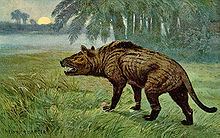Scientific name Hyaenodon Higher classification Hyaenodontidae Order Creodonta | Family †Hyaenodontidae Phylum Chordata Rank Genus | |
Similar Creodonta, Entelodont, Andrewsarchus, Daeodon, Entelodon | ||
Hyaenodon jurassic park builder glacier ep27 hd
Hyaenodon ("hyena-tooth") is the type genus of Hyaenodontidae, a group of extinct carnivorous fossil mammals from Eurasia, North America and Africa, with species existing temporally from the Eocene until the middle Miocene, existing for approximately 26.1 million years. The various species of Hyaenodon competed with each other and with other hyaenodont genera (including Sinopa, Dissopsalis and Hyainailouros), and played important roles as predators in ecological communities as late as the Miocene in Africa and Asia. Species of Hyaenodon have been shown to have successfully preyed on other large carnivores of their time, including a "false saber-tooth cat", Dinictis by analysis of tooth puncture marks on a fossil Dinictis skull in North Dakota.
Contents
- Hyaenodon jurassic park builder glacier ep27 hd
- Hyaenodon duo vs andrewsarchus
- Description
- Tooth eruption
- Range and species
- References

Hyaenodon duo vs andrewsarchus
Description

Some species of this genus were among the largest terrestrial carnivorous mammals of their time; others were only of the size of a marten. Hyaenodon is one of the longest lived genera of Hyaenodontidae, and is known from the Late Eocene to Early Miocene. Remains of many species are known from North America, Europe, Asia and Africa (In 1993 42 species were distinguished).
Typical of early carnivorous mammals, individuals of Hyaenodon had a very massive skull but only a small brain. The skull is long with a narrow snout - much larger in relation to the length of the skull than in canine carnivores, for instance. The neck was shorter than the skull, while the body was long and robust and terminated in a long tail.
The average weight of adult or subadult H. horridus, the largest North American species, is estimated to about 40 kilograms (88 lb) and may not have exceeded 60 kilograms (130 lb). H. gigas, the largest Hyaenodon species was much larger, being 500 kilograms (1,100 lb) and around 10 feet (3.0 m). H. crucians from the early Oligocene of North America is estimated to only 10 to 25 kilograms (22 to 55 lb). H. microdon and H. mustelinus from the late Eocene of North America were even smaller and weighed probably about 5 kilograms (11 lb).
Compared to the generally larger (but closely related) Hyainailouros, the dentition of Hyaenodon was geared more towards shearing meat and less towards bone-crushing.
Tooth eruption
Studies on juvenile Hyaenodon specimens show that the animal had a very unusual system of tooth replacement. Juveniles took about 3–4 years to complete the final stage of eruption, implying a long adolescent phase. In North American forms, the first upper premolar erupts before the first upper molar, while European forms show an earlier eruption of the first upper molar.
Range and species
In North America the last Hyaenodon disappeared along with species like H. brevirostris in the late Oligocene. In Europe they had already vanished earlier in the Oligocene. From the Miocene in Africa there are three species (H. andrewsi, H. matthewi and H. pilgrimi) known, but none of these reached the dimensions of Asian species like H. gigas and H. weilini.
